Making tonkotsu ramen at home is truly a labour of love. This isn’t some 15 minute miracle insta-ramen recipe. This isn’t even some one day recipe.
Making authentic tonkotsu ramen takes time. It takes effort. You have to be a bit crazy to go there. But it’s so good. It’s totally worth it.
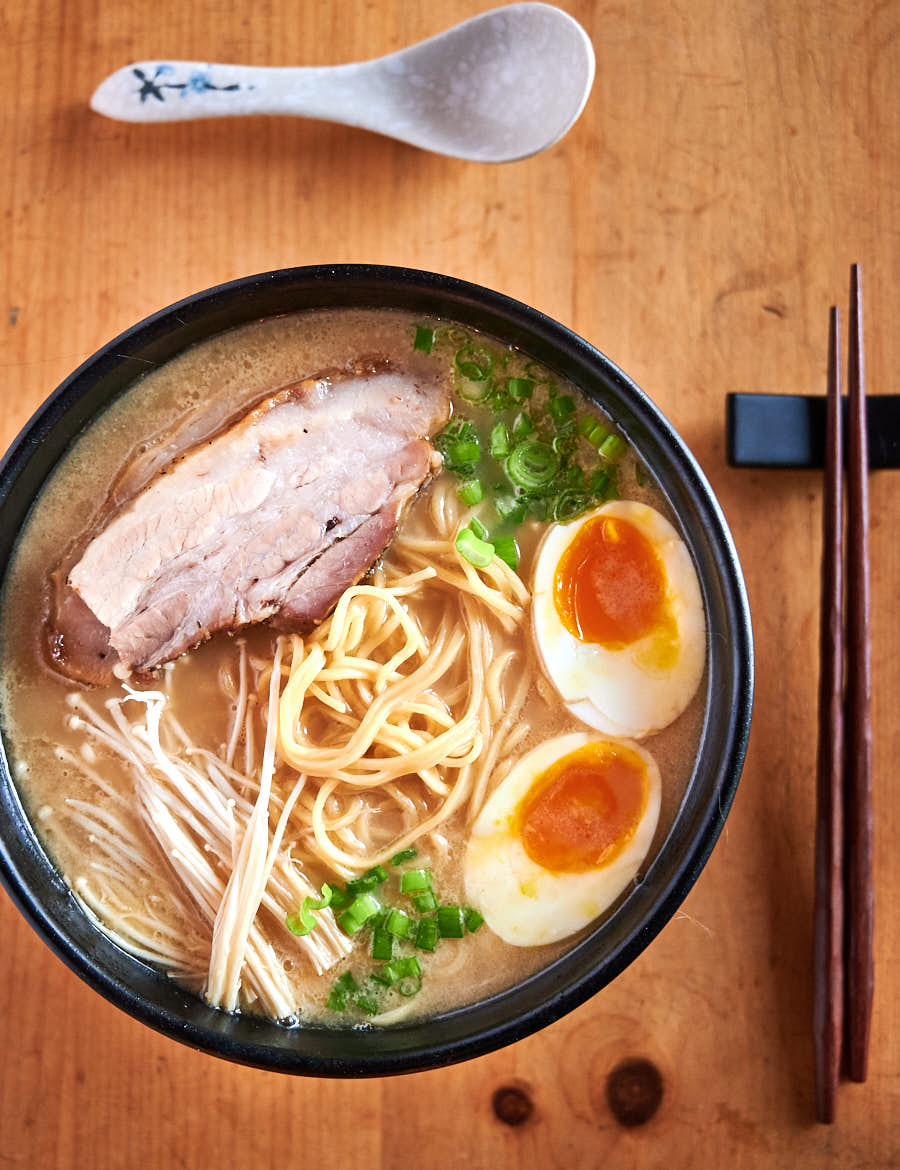
There are restaurants in Japan that do nothing but make tonkotsu ramen. Just big wonderful pots of the most amazing broth. Perfect noodles. Silky eggs and unbelievable pork. I’ve had it. And I love it.
This recipe may not quite hit the level of Japanese ramen making. People have devoted their whole lives to mastering the art. But it’s pretty damn good. And it’s way cheaper than a plane ticket to Narita.
There are five major ingredients
Tonkotsu ramen has five major ingredients. Broth. Noodles. Pork. Egg. Tare. Each is important and each takes some doing.
Tonkotsu broth is the heart and soul of any tonkotsu ramen. It’s not difficult but it takes time – 12 to 18 hours. Mostly unattended but you can’t rush this. You can make lots and freeze it though. Two bowls or twenty. Doesn’t matter at all as long as you have a big enough pot.
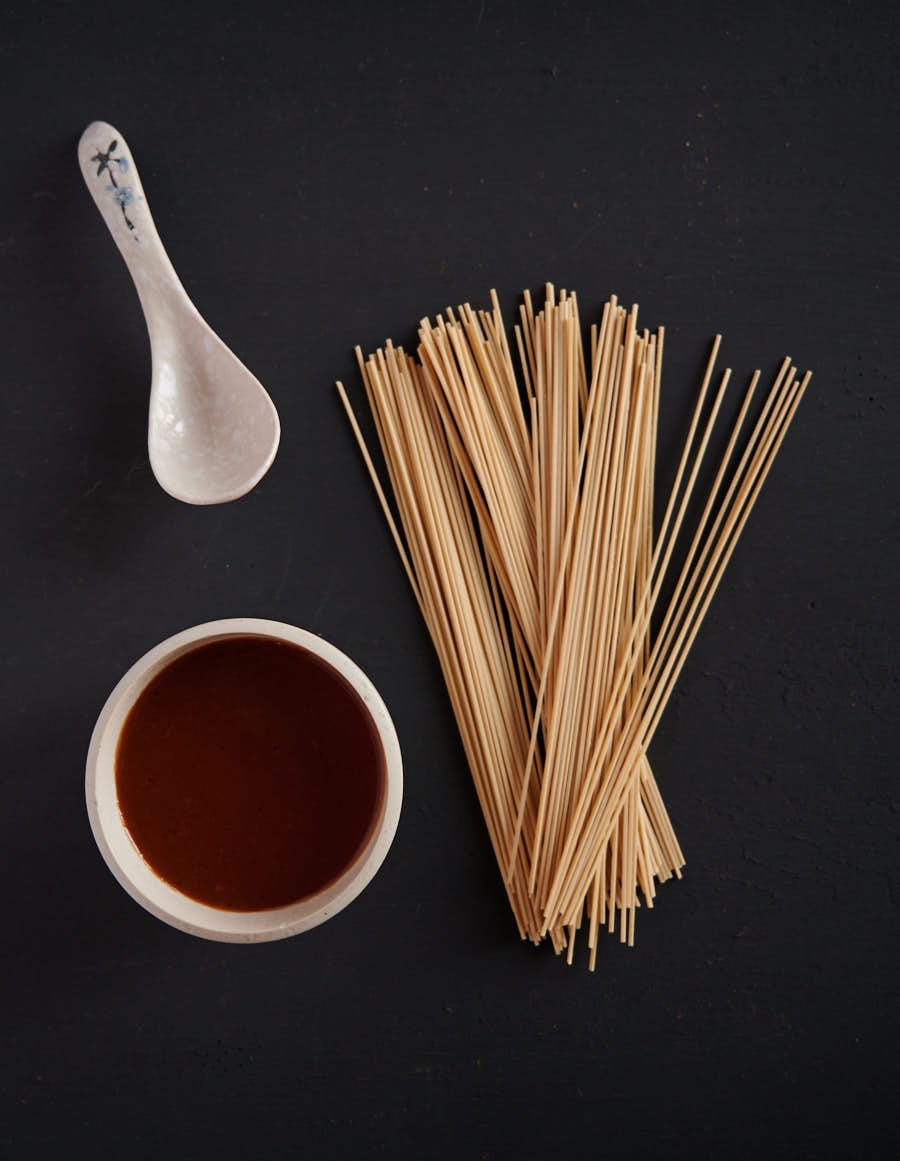
The noodles are key
The noodles are the backbone. Noodles were where I struggled the most. The fresh ramen I can get in town sucks. Like really sucks.
Ramen noodles are different. They are alkalinated. That’s a fancy way of saying you put baking soda in the dough. Asian stores sell dried Japanese ramen. Look for sodium carbonate or potassium carbonate in the ingredient list.
If you can’t find any, another trick is to boil spaghettini or capellini in 8 cups of water with 2 Tbsp of baking soda. That works too.
Please don’t use packaged dry instant ramen noodles. Those are completely different. I like them in an I like KFC sort of way (as in I eat it once every few years and then wonder why I did that) but for this they are so wrong…
The pork is called chashu. It’s marinated pork belly and it’s magic stuff. I do mine sous vide for 11 hours at 170F. Conventionally cooked chashu recipes are all over the internet.
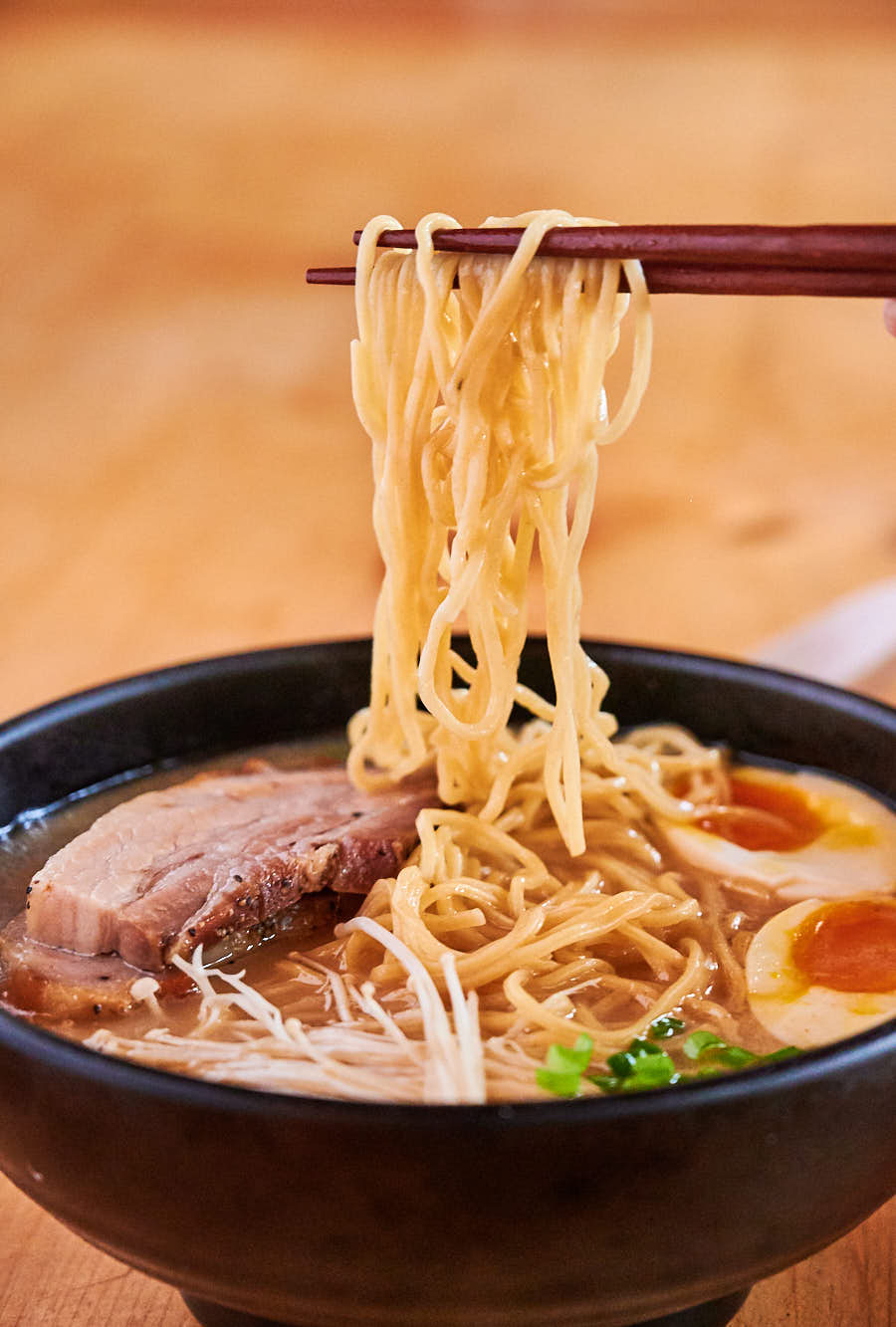
The eggs and the seasoning
Tonkotsu ramen is usually served with medium boiled eggs. I didn’t even know there was such a thing as medium boiled egg until I discovered ramen. Medium boiled is about a 7 minute egg. The whites are firm. The yolk are just barely set. Just so good.
The tare is the flavour base. This is where you take your ramen in your direction. It can be as simple as salt or as complicated as bacon infused sweet soy miso tare. Up to you.
Pull these 5 elements together and you have wonder in a bowl. If you don’t understand why you’re reading this and think I’m crazy google the best ramen joint in your town.
Go taste for yourself. Then judge me. It may seem daunting but it’s a few manageable steps. Totally doable if you want it bad enough.
This is adapted from several recipes from the internet. The soy bacon tare is a based on David Chang’s Momofuku Tare 2.0. The chashu pork marinade is from Serious Eats. The tonkotsu ramen broth is the best of a bunch of recipes on the net.
Tonkotsu ramen. It’s real work. But it is so worth it.
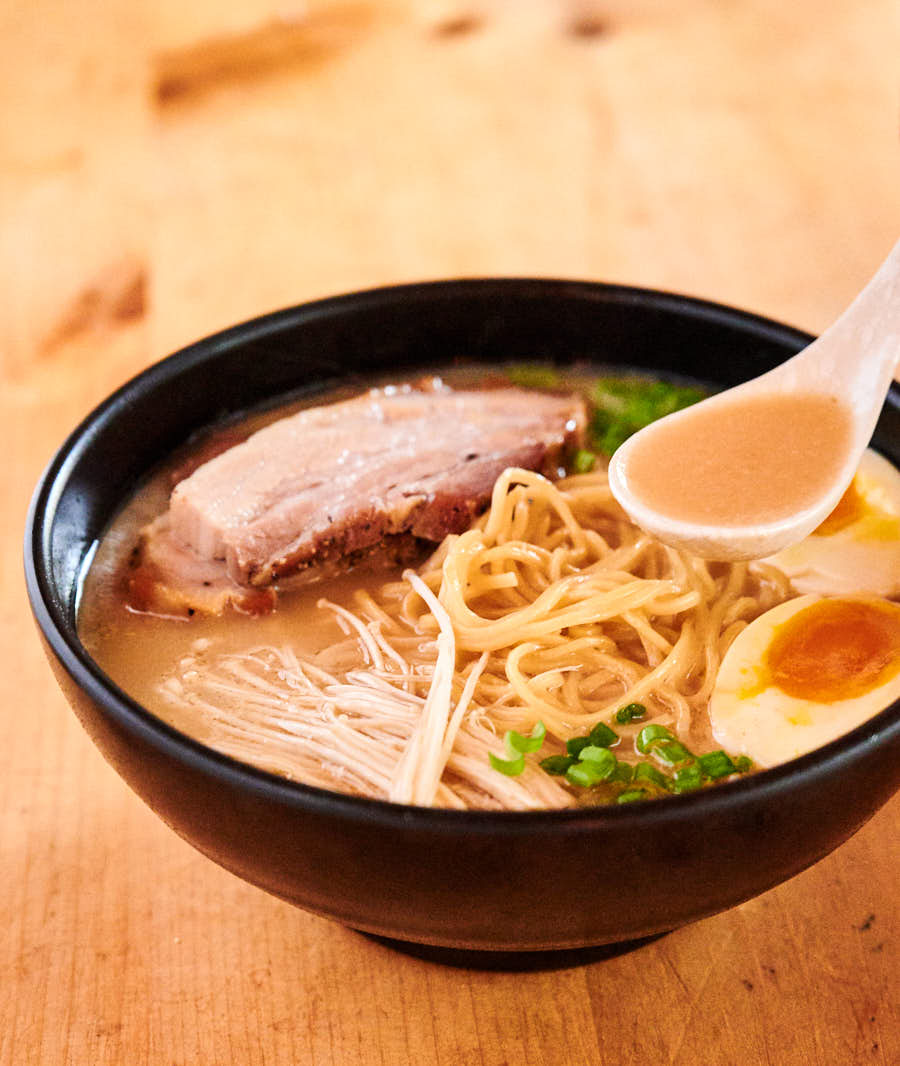
Update: Since I wrote this post I learned how to make Momofuku pork belly. If you’re interested I actually got a lesson in the kitchen at Momofuku Las Vegas. So I’m pretty sure it’s the real deal.
I still love the sous vide chashu pork belly and make it regularly. But the Momofuku pork belly is really good too. And you don’t need a sous vide to make it.
I’ve taken new pictures since this was first published. The new pictures have the Momofuku pork belly in them. So if you make chashu pork don’t be alarmed if it looks different. It is different. I cannot decide which one I like better.
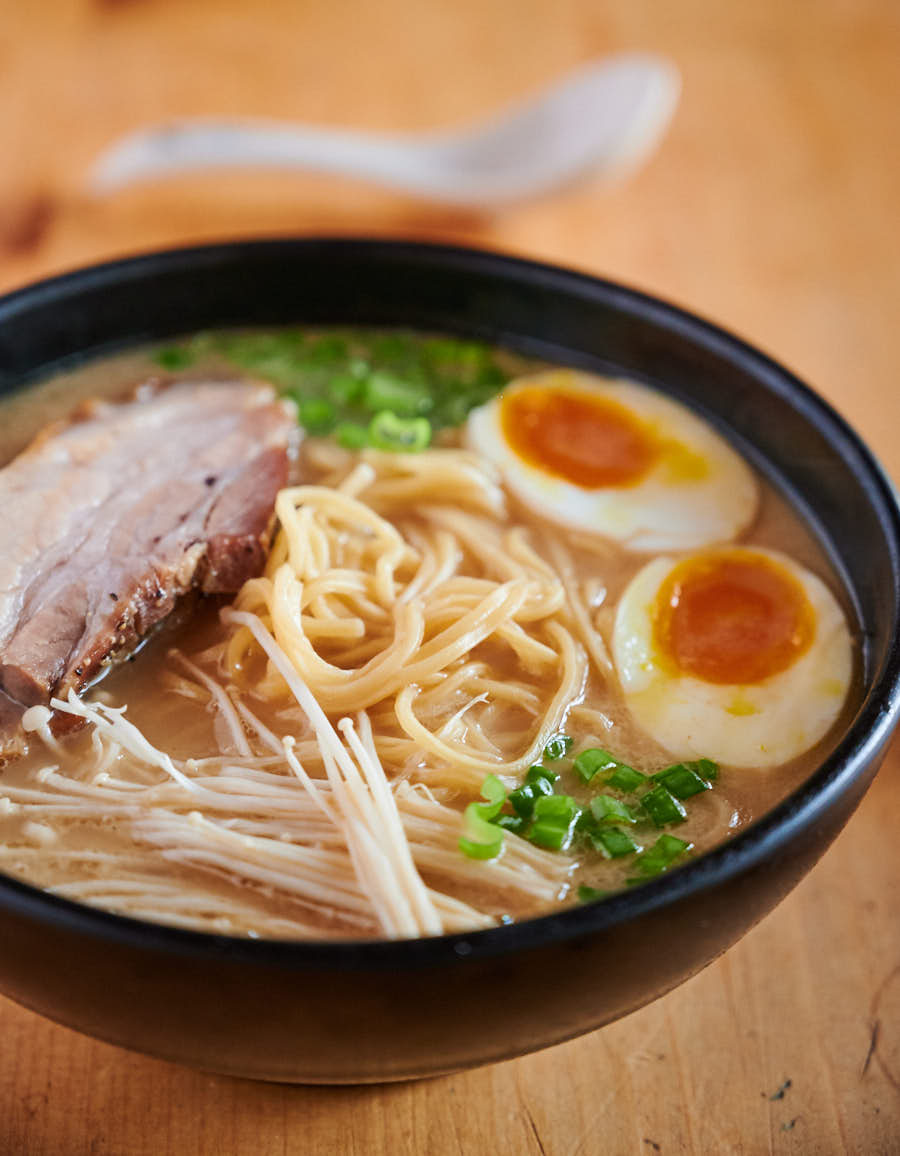
tonkotsu ramen
Ingredients
Tonkotsu ramen
- 8 cups tonkotsu pork broth – recipe link below
- 12 oz good quality dried ramen noodles
- 4 large or extra large eggs
- 2-3 oz enoki or other mushrooms
- thinly sliced green onions
Chashu pork belly
- 2 lb pork belly – rolled and tied
- 1/4 cup soy sauce
- 1/2 cup sake
- 1/2 cup mirin – sweet Japanese wine
- 1/4 cup sugar
- 2-3 cloves garlic – left whole
- 2 green onions – coarsely chopped
Soy bacon tare
- 2 slices bacon – use good quality bacon here
- 1/4 cup soy sauce
- 2 Tbsp mirin
- 2 Tbsp sake
- 4 Tbsp shiro miso
Miso Tare
- 1/2 cup shiro miso
- 1/4 cup sake
- 1/4 cup mirin
- pinch shichimi togarashi (optional)
- 1-2 tsp kosher salt – depending on how salty you like your ramen.
Instructions
Chashu pork belly
- Combine the soy, sake, mirin, sugar, garlic and green onions in a ziploc bag large enough to hold the pork belly. Stick a straw in the bag and seal the ziploc bag up against it (so the straw is the only opening). Suck as much of the air out as you can and seal.
- Sous vide the pork for 10-11 hours at 170F.
- Remove pork from the ziploc bag. Discard the bag and marinade.
- Let the chashu pork belly cool completely.
- Slice across the chashu pork (so you get bacon like slices) – into 8-12 slices about 1/8 to 3/16 inches thick. Reserve. You won’t need all the pork for 4 servings.
Soy bacon tare
- Combine all the ingredients in a small sauce pan. Simmer at the lowest setting for about an hour. Top up with a bit of chicken stock if needed.
- Remove the bacon.
Miso tare
- Combine all ingredients in a small sauce pan and simmer at the lowest setting for about 5 minutes.
Medium boiled eggs
- Bring enough water to cover the eggs to a boil. If you have a way to prick the eggshell do it. Boil large eggs for 6 minutes 30 seconds. If using extra large eggs boil them for 7 minutes 30 seconds. You may have to adjust your times slightly depending on the exact size of your eggs but this should get you pretty close.
- Submerge the eggs in cold or ice water to chill. This stops the egg yolks from continuing to set up. Peel. Cut in half right before you serve your tonkotsu ramen.
Assemble the tonkotsu ramen
- Boil the ramen noodles in plenty of water as directed by the packaging. If there’s no translation on the packaging usually its 4 minutes. You don’t need to salt the water.
- Cook the mushrooms along side the noodles – you just want them softened.
- Gently fry the chashu pork in a non-stick skillet until lightly browned.
- Place 1/4 of whichever tare you are using in the bottom of four bowls.
- Ladle in about 1/2 cup of the tonkotsu broth into each of the bowls and stir to mix.
- Add the noodles. Pour in another 1 1/2 cups of the tonkotsu broth per bowl.
- Top with the egg, mushrooms, pork and green onions.
Notes
Nutrition


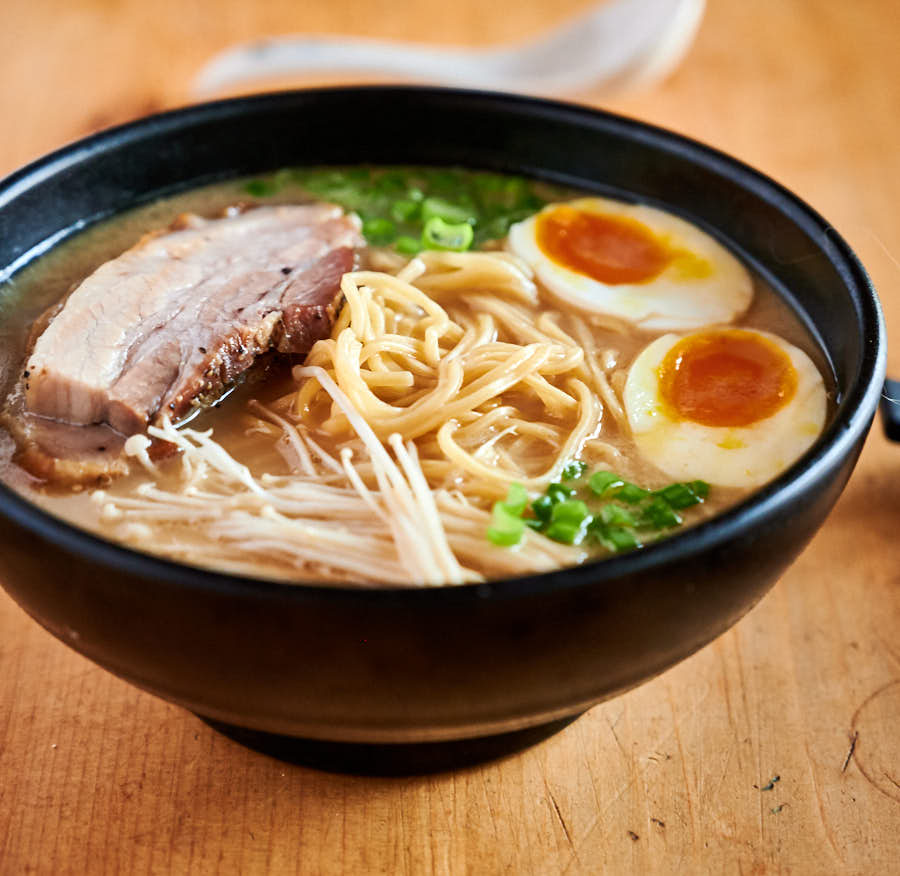
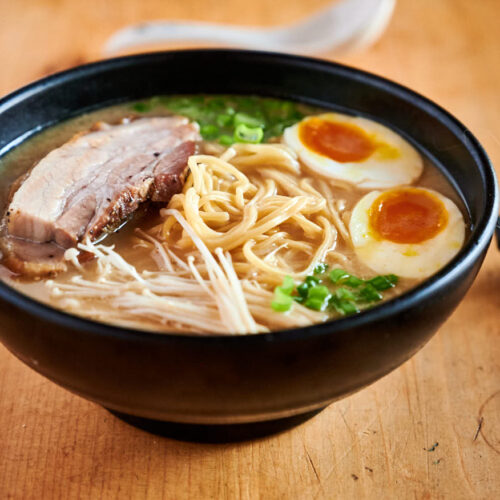
What kind of pork bones? My older kids are requesting this for dinner this Sunday… thanks!!!
I use pork neck bones because that’s what they have at my Asian grocery but I expect any bones with a bit of meat on them would do. A mix of different bones isn’t a bad idea.
You reminded me the 1985 Japanese movie Tampopo by Juzo Itami?
Haha. Will have to check that one out. The summary on wikipedia sounds great.
yummy recipe 🙂
WOW! Made this last night and it was AMAZING! If we wanted to make a spicy version of this ramen bowl, how would you suggest we do that? What peppers? When and where would you add them? Thanks in advance and this recipe was absolutely amazing.
Glad you liked it. I would be a little worried about overpowering the broth with spice but if I were going to do it I would add some chili sauce (or gochujang) to the tare.
Could this be made in an instant pot to cut down some of the cooking time?
I am assuming you mean under pressure? I really have no idea. If I had to guess I would guess probably not but I do not know. For sure it wouldn’t work in slow cooker mode.
Can I make more tare and freeze the leftovers to use later? Have you tried this?
I have never tried that. I really couldn’t say if it would work. Maybe freeze some leftovers and just taste it the next day?
I use a topping that comes from Ivan ramen: black garlic oil. It’s super easy to do and VERY tasty (and lasts ages). I make it and put it into a squeeze bottle. I usually leave the chili paste out, honestly, so it’s just the oil. It’s really good.
Burnt garlic oil This is an incredible condiment and is great on anything!
1 C canola oil
1 C sesame oil
3 T Sambal chili paste
100 g whole peeled garlic cloves
Thanks. I am going to try this ASAP.
Do you just cook all these ingredients together until fragrant Nd brown?
I tried this recipe last night and it worked out great! I chose to roast the pork instead of sous vide it to save time. This recipe deserves to be shared! I hope you don’t mind if I post a photo on my Instagram, diy_bucket_list and tag you in it.
I’m so glad it worked out for you. It’s a bit of an epic recipe but the results are worth it I think. Please do post on Instagram and thank you!
In your Soy bacon tare…you stated soy? Is that soy paste?
Sorry – recipe corrected. It is soy sauce.
Hey! I just had the joy of trying this recipe last week, and I wondered if I could post one of your photos, with a link to your site, on my blog? I like to recommend good recipes every week.
Let me know if this is ok! I would not share your recipe, just direct my viewers to your page with your picture and website link. 🙂
Thanks for the great recipe!
Naomi, I would be honoured. Thank you!
I love how you rigged the sous vide! I’ve wanted to do it but didn’t want to invest in an expensive machine. My pork belly is simmering away in its plastic bag as I write this. I’m checking the temperature of the water and hope it’s hot enough. If not, I’ll transfer to a Dutch oven. My bones are simmering away, too.
I lived in Japan for a year and loved the ramen I had there. I searched for a good recipe and picked yours. Here’s hoping for a good result for my first attempt!
I am a huge ramen fan and hunt it every time I go to Japan. I’d say this recipe will get you to near Japanese levels for the broth, pork and eggs etc. The noodles though. Really I have not found anything that comes close to fresh handmade Japanese noodles. I use the dried ones from Japan (thin). Someday I’m going to try to figure out how they do it…
Hello! I tried this today, and I love how straightforward and simple the instructions were. I bought a mixed bag of pork bones and boiled them for just slightly more than 12 hours. Unfortunately in the last hour, the bones seemed to have really broken down and got a bit messy in the broth. After straining I only got 4+ cups of broth… would you say it’s because there was too much meat on the bones? I did try to strain as much as I could out.
Also, how do we know that we’ve made good broth? Thx!
Glad you liked the recipe Marilyn. I would imagine winding up with 4 cups would be simply because you needed to add a bit more water as it boiled or the bones were packed in tightly so there wasn’t as much room between them for the water. In any case, winding up with 4 cups is easily fixed. Just dilute it with some water to get to 8 cups or so. To test the broth take a small ladle full, add a bit of salt and taste. If you have good depth of flavour you know you’ve made a good broth. In this case, though, I can’t imagine you didn’t. All that extra meat adds flavour.
Reading your thought stream is a delight. I enjoy your banter and share much of your humor. I am preparing your tonkostu recipe as I type, yet I am doing it in a pressure cooker to remove some of the time. I know I have to replenish liquid and move things around and such, and hopefully by 6pm tonight I will have given it 14 hours worth of cooking.
I enjoy your blog.
So glad you like the blog (and my sometimes strange sense of humour:-) I never thought of cooking tonkotsu ramen broth in a pressure cooker. I’d be very interested in hearing how that goes.
Hello:) was wondering if you can also post a tsukemen recipe?:) this is the dipping noodles right?
Hi! I wasn’t thinking about trying to do a post about tsukemen – dipping noodles – but that’s a good idea. Thanks!
This looks really good and well worth a try. I had some great Ramen when I worked in NYC a few years ago and some good Ramen in Manchester but other than that I stick with a quick recipe at home but I’ve always wanted to turn it up a notch and I think this could well do it. Many thanks
It’s a crazy amount of work making the broth and the pork takes some doing as well but it is as good as a most ramen joints serve. Good luck!
Love love love me some ramen! And I always feel like the medium boiled egg is the key ingredient. The meat is always hard for me –
I always end up just doing chicken, but the pork in this recipe definitely kicks it up to the real deal! Thanks for making it so easy!
Wow! I was intrigued by the photo and then even more impressed with the process! I’m a pretty lazy cook but this would be perfect to make for my daughter for her birthday or something, she loves ramen! Definitely pinning for September;) Thank you!
I absolutely LOVE a good bowl of ramen! Whenever we go to a “big city,”I always have to find the best ramen joint in town.:) However, I have never been brave enough to make it at home (besides you know, the packaged stuff, haha!). These instructions are wonderful! It may be a time consuming process, but for a good quality ramen at home, I’d say it is absolutely worth it. Can’t wait to try it!
I’ve never agreed with a statement more. Chashu is DEFINITELY magic stuff! I can’t believe you made a ramen that looks this good and is so authentic at home. I love a good bowl of ramen, but have never dared to make it at home, for fear of messing up this perfect dish. Now, I don’t have to be scared anymore because of your awesome step-by-step instructions. I’m definitely going to try this out!
It’s an epic recipe but I think it’s worth it. And it’s a starting point. You can take it a few different ways with the tare and toppings so you can make a big batch of tonkotsu and not get bored!
Like you said, this looks like it would be worth all the work! I used to have so many amazing Ramen choices in New York, and I haven’t found a spot locally yet. Now I can enjoy those deep, comforting flavors at home.
It is a lot of work but you can make big batches of tonkotsu broth at once and then freeze it for a quick ramen fix. Just substitute something else for the pork belly and it’s a weeknight dinner.